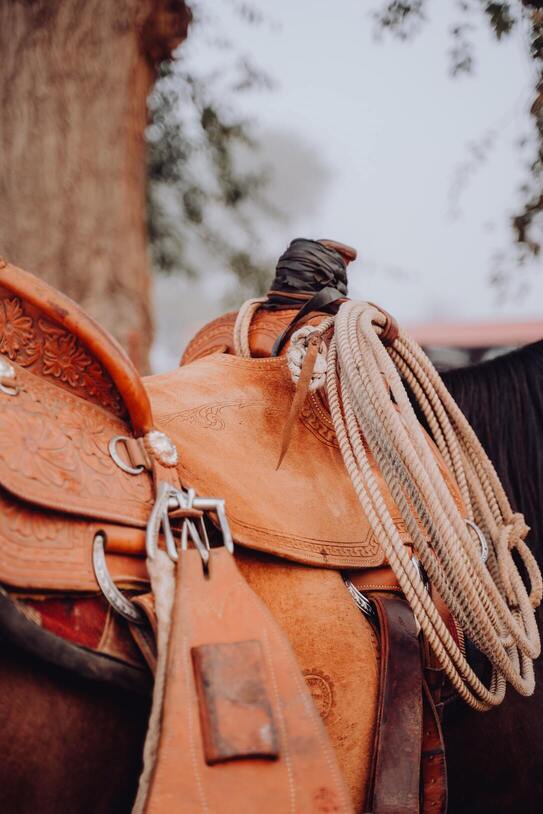If it’s the first time you’ve cleaned your saddle, we recommend that you try a leather-specific cleaner, but a saddle-specific soap or glycerine soap will also get the job done. It is worth remembering that if you decide to use an all-in-one style cleaner that states that it will both clean and condition, it can often contain some detergents that are actually damaging to the leather, leading to potential discoloration.
Cleaning the leather
Using a damp sponge, apply a light layer of a suitable soap, or leather cleaner to your saddle in small circular patterns, ensuring that you are thoroughly covering all surfaces of the saddle (the top, underside, and between saddle flaps). Be mindful not to scrub too hard, but with just enough pressure to remove any debris. You should also aim to avoid suede patches of your saddle, as these require a different style of cleaning - which we'll get onto later!
If you are cleaning an
English saddle, you should be careful not to use too much water on the underside of the saddle as this can damage the wool flocking located underneath the leather. If you find that the sponge becomes dirty during the cleaning process, simply rinse. You don't want to rub dirt into your saddle; you want to scrub a clean substance (your cleanser of choice) in.
if there are areas of your saddle that have built up thicker layers of grime, such as underneath the stirrups, you can repeat the cleaning process a few times (although ensuring not to wet the leather too heavily) to remove debris that is tougher to shift).
You can simply brush the underside of a
Western saddle with a stiff brush to remove any debris and build-up.

Cleaning off Residual Soap
Use a lightly damp cloth to wipe the saddle clean of any soap residue. You should aim to thoroughly remove any remaining soap from the leather after it has been cleaned to prevent harm to the leather in the long run, as residual soap left on the saddle can sometimes hold grit, therefore damaging the leather in the long run. Don't forget to clean out the folds and crevices of the saddle, as well as the stitching. You can use a cotton swab if you are struggling to reach certain areas effectively.

Conditioning the leather
Next, you should apply a (non-detergent) leather conditioner to your saddle. You don't want to overapply conditioner to your saddle, as this can penetrate through the tree of the saddle, as well as the padding beneath. Over-applying can also encourage dirt to cling onto the surface of your saddle, as well as clog the pores of the leather. Thick conditioners such as beeswax may leave a residue on the leather, so have dry towels and elbow grease on hand to clean it off. We encourage you to view directions on your chosen leather conditioner to ensure that you're getting the right guidance from the manufacturer and making the most of the product.

Cleaning the metal fittings of the saddle, as well as the stirrup leathers
Using a dry cloth, wipe down all metal fittings, such as stirrups or buckles, and clean any excess cleaner that may have accumulated on them. Just like the hard-to-reach areas of the saddle itself, you can use a cotton swab to ensure you're thoroughly cleaning these fittings. Apply a high-quality silver polish to the buckles and trim of your saddle if needed, just be sure to avoid getting the polish on the leather.

Follow the same steps of applying soap and conditioner to clean the stirrup leathers.
Stirrups can be cleaned with a metal cleaner, but they may also be washed using ordinary soap and water. Regardless of what you choose to use, ensure that you rinse thoroughly. If you clean the metal fittings on the saddle with a metal cleaner, make sure not to get this on the leather too. You can simply place some fabric between the metal and leather when carrying out this process in order to avoid this happening.

Suede care
Now and then you may feel as though the suede on your saddle needs a new breath of life. You can simply use a stiff bristle brush to brush up the nap. This should also remove any excess grime that may be held by the material. Ideally, you don't want to do this too frequently, as excessive brushing will actually wear through the suede quickly, and can result in holes or bald spots. You can spot clean suede areas of your saddle with a lightly dampened cloth, but you don't want to use too much water in this process as it can result in a loss of texture.

Storing your saddle
To keep your horse tack in good working order, it is necessary to clean and maintain it on a regular basis. If you do need to store it for an extended period of time, make sure you thoroughly clean and moisturize it first. It's preferable to store your saddle in a temperature-controlled environment since extreme heat and cold can harm the leather.
In order to allow your leather to breathe whilst ensuring it stays dust and dirt-free, you can cover it in fabric or newspaper. Also, be sure to check it for mildew on a regular basis. It's a good idea to nourish your saddle regularly to ensure that the materials don't dry out. Sometimes, when food is scarce, leather attracts rodents, so be sure to store your saddle in a safe place that is out of reach of any hungry rodents!
We hope you found these suggestions helpful, and that the next time you go for a ride, you can sit in a clean and well-cared-for horse saddle with no concerns! If you have any questions, please don't hesitate to reach out to us. Thanks for reading and happy riding!



